“Friends Who Never Grow Stale”: A Historical Novelist Steeped in Howard
Wednesday, May 2, 2007
posted by Steve Tompkins
 Print This Post
Print This Post
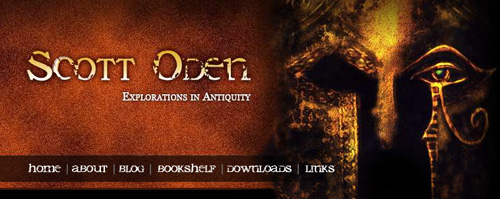
Quick — name the opposing sides at the battle of Pelusium. No? Okay, who were the besiegers and the besieged at Halicarnassus? If you don’t know, but would like to, or do know, and are intrigued by the thought of fiction that re-creates these ancient history flashpoints, I recommend unto thee novelist Scott Oden, the author of Men of Bronze (2004), Memnon (2006), and the upcoming Lion of Cairo. It might seem as culturally improbable for rural Alabama to produce a superior historical novelist as it was for Cross Plains to produce a world-class adventure writer and weird fictionist, but the hinterland, Erlik be thanked, continues to be full of surprises.
In a December 23, 2004 post to his blog (one of the friendliest to initiated and uninitiated alike that I’ve yet seen) Oden wrote “I am, and will always be, my first reader. I write stories I’d enjoy, stories I’d buy.” That must be the reason why others have been enjoying, buying, and even translating him into different languages (the best historical fiction sneers at borders, linguistic or political). In March Men of Bronze gave me one of the best calling-in-sick days of my entire life in the workforce, and Morgan Holmes also took time out from his recent agenda of drop-kicking a certain newcomer to matters Mak Morn-ian off the white cliffs of Dover to devour the novel.
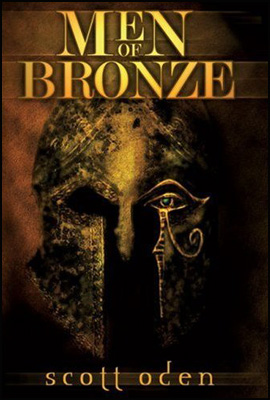
Oden’s original pitch promised that Bronze would “appeal to those readers who loved the great adventure pulps of Robert E. Howard and Harold Lamb as well as the more modern tales of Steven Pressfield and Mary Renault,” and the Howardian DNA that makes up his hero Hasdrubal Barca (yes, from a branch of the family that would give Romanophobes Hamilcar and Hannibal) requires no laboratory testing. The owner of eyes “like splinters carved from the iron gates of Tartarus,” Barca is susceptible to possession by “the Beast,” (a berserker-persona), and he leads the men-of-many-tribes-and-many-crimes Medjay who guard Egypt’s eastern border against Bedouin raids “with the tigerish strength of a born killer.” “True to his roots as a Robert E. Howard homage,” Oden tells us in one post, ‘Barca is a man of action, kill first, ask questions later,” and the character’s exploits unfold against a truly canny backdrop. His creator identifies himself as “an ancient Egypt addict — a pharaonic hophead,” but for Bronze he selected a period that has been more ignored than explored, the twilight of the 26th (Saite) dynasty, the hoplite-hedged reign of Amasis (Ahmose II) just before the Persian conquest in 525 B. C. Oden must have been wryly aware of the primary-if-pseudo-historical associations that several of the contingent-names in the army of Cambyses, the son of Cyrus, would have for many readers:
The Immortals, so named because their ranks were always at ten thousand — never more, never less — formed the core of the invading force. Around them were arrayed the men of Persia, Media, Chaldea; turbaned Cissians from the mountainous regions east of Susa fought beside Assyrians from the upper Euphrates, while Hyrkanians from the fringes of the Caspian sea worked in tandem with their one-time enemies, the Sacae. The Great King of Persia employed his share of mercenaries as well: hoplites from Ionia and Caria; peltasts from the eastern Aegean, savage Thracians; even remnants of the Cimmerian horde.
The Persians might deploy some Ionians, but the Egyptians have all but surrendered their birthright to Greek sellswords who swagger through the realm they’re supposedly defending much as Hengist and Horsa’s warbands must have when Vortigern hired them to preserve Romano-British civilization, or Cortés’ conquistadors might have had they arrived in Tenochtitlan as mercenaries meant to be Montezuma’s shocktroops. Both Barca in Men of Bronze and Memnon of Rhodes in the eponymous novel are on the “wrong,” or at least the losing, side of history (the Persian Empire waxes in the first book and reels in the second), which fact helps to invest Oden’s protagonists with what Ivan Morris (in a samurai context) called “the nobility of failure.” It makes them a little more Howardian, too; and by this point it should comes as no surprise that this novelist’s influences are simply unimpeachable, prominent among them “a pair of fantasy writers: Robert E. Howard, the Texan who invented the character of Conan the Cimmerian in the 30s, and Karl Edward Wagner, creator of the ultimate anti-hero, Kane. Mary Renault inspires me to want to be a better writer, as does Steven Saylor.” In fact his every second post seems to include an admiring or affectionate mention of REH: “Robert E. Howard was probably the best at using historical references in his fantasy: Conan of Cimmeria evokes images of barbaric splendor; his place names achieve the same results. Stygia is his evil, wizard-haunted land, and the name reflects it.” Elsewhere he plugs Howard’s taste in epigraphs, pronounces ‘Black Colossus'” “excellent” (Does the Pelusium set-piece in Men of Bronze contain just a hint of Shamla Pass?) and lists The Hour of the Dragon right after LOTR as one of the “Five Books That Mean a Lot to Me.” In another post, some meteorological pyrotechnics remind him of one of the bravura passages in “the Grey God Passes.”
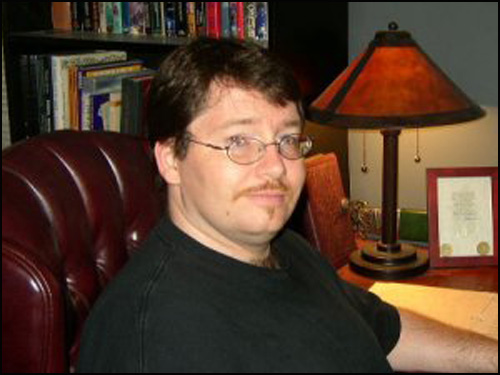
Oden has been to Cross Plains, and refers to his “Egyptian shelf, Greek shelf, and REH shelf.” On March 10, 2005, while gearing up for a Conan RPG session, he mused “It’s hard to imagine the lure REH has for me. His were among the first stories I can remember reading on my own. . .The stories of Texas native Robert E. Howard have stuck with me for all of my life. They’ve influenced my own life, and provided outlets of barbaric splendor during times when not much else in my life was splendid. They are friends who never grow stale.” He cops to being tempted by Ace’s Age of Conan series: “The idea behind the series is, to me, brilliant” — alas, so far, the authors have been handcuffed to Conan’s own lifetime, and thus barred from the enticing mega-events that occur earlier or later in the Hyborian Age. In a January 2007 post, he wonders “Why do all my characters have colossal chips on their shoulders and a propensity for violence?” In February: “It’s always been my belief that [the books] have more in common with heroic fantasy than with mainstream historical fiction. Part of this has to do with the writers I choose to emulate — Robert E. Howard, Karl Edward Wagner, and Tolkien, just to name some names — and part of it has to do with my own vision of the ancient world.”
Best of all is his “Happy 100th, REH” post of January 22, 2006, definitely worth reading in full. Here’s the finish: “So tonight, I raise a toast to the shade of REH, who has probably set as many aspiring authors on the road to publication as Hemingway ever did. I know this one owes him a tremendous debt of gratitude.”
Although Oden is deplorably unfamiliar with Dorothy Dunnett (who rules modern historical novelists the way Yasmeena does the Yagas on Almuric), he’s something much more valuable than another kindred spirit — he’s a kindred spirit who can write. I was worried that he would have to tear down Alexander to build up Memnon, perhaps even echo the leyenda negra propagated by Peter Green, A. B. Bosworth and especially Victor Davis Hanson. Before embarking upon his second career as Dick Cheney’s bidet, Hanson wrote some very fine books (The Western Way of War, The Other Greeks, The Soul of Battle), but even during that productive period his screechily shrill denunciations of Alexander reached a chandelier-exploding crescendo in The Wars of the Ancient Greeks (1999)
Too many scholars like to compare Alexander to Hannibal or Napoleon. A far better match would be Hitler, who engineered a militarily brilliant but similarly brutal killing march into Russia during the summer and autumn of 1941. Both Alexander and Hitler were crack-pot mystics, intent solely on loot and plunder under the guise of bringing ‘culture’ to the East and ‘freeing’ oppressed peoples from a corrupt empire. Both were kind to animals, showed deference to women, talked constantly of their own destiny and divinity, and could be especially courteous to subordinates even as they planned the destruction of hundreds of thousands and murdered their closest associates.
That passage doesn’t even work as hysteria, let alone history. Oden’s basileus Alexandros is nothing like Hanson’s travesty, nor does he resemble the Oliver Stone/Colin Farrell impostor who seemed incapable of conquering so much as the child-proof cap keeping him from his psychotropic pills. Memnon fills in part of the gap between Mary Renault’s much-loved Fire From Heaven and The Persian Boy, and the novel’s Alexander retains his Renaultian charisma and genius but (from a Persia-aligned perspective), understandably appears to be what the Germans term a Raubtier, a beast of prey. While Memnon is a guest-friend of the Macedonian court the teenaged prince puts him “on edge. He reckoned it akin to watching an adolescent lion — lean and hungry — amid a flock of sheep, trying to apprehend when its rampage would begin.” For me it was fascinating to compare Oden’s Philip, Parmenion, and Alexander not only to Renault’s (or the mature conqueror reflecting on his fantastically eventful life in Pressfield’s The Virtues of War), but also to the warrior-king, veteran general, and golden heir of David Gemmell’s Alexandrian sword-and-sorcery novels Lion of Macedon and Dark Prince.
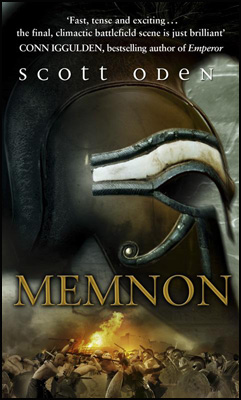
It’s a pleasure to report that Oden got better in between his first and second novels. Of the Diadochi, Alexander’s empire-coveting field marshals, a character says: “He made them, make no mistake, and in dying he unleashed a plague upon the world — a plague of warmongers, bereft of their master’s grace. In his day, Xerxes should have obliterated the Macedonians on his march to Greece.” Athens, long after being robbed of its Periclean afflatus by the trauma of Sicilian expedition and tyranny of The Thirty, is dismissed as “a city of panderers and demagogues.” And here’s one of the first battlefields Memnon survives:
A swath of destruction stretched a mile in width and continued on for two, the field of Ares. The War God disdained oxen, preferring to let the yoked power of contending armies harrow his demesne. Into this flayed earth poured the fluids of war, the swaet and blood, the bile and bowel, the coward’s piss and the dying man’s tears, mingling to form a sludge that clung to the ankles of those men left standing.
As for the aforementioned siege of Halicarnassus (334 B.C)., heretofore overshadowed by Alexander’s epic, succeeding-where-Nebuchadnezzar-failed taking of Tyre, in Memnon it threatens to move into the elite company of Wagner’s Lynortis (“Lynortis Reprise“, Dros Delnoch (Legend), and of course Minas Tirith.
Visitors to Oden’s website can witness deadlines and distractions warring against each other like the Æsir and the Vanir, and share in his euphoria as he completes Memnon: “Principal photography has wrapped, the stars have gone home.” They can also follow the short unhappy life of Medjay, a sequel to Men of Bronze that plagued the writer like the demonic monkey in Le Fanu’s “Green Tea” until, as documented by a post on Sept. 21, 2006, he finally pulled the plug and rebounded by fleshing out a colleague’s suggestion for “an Arabian Nights-style book, something in the tradition of Robert E. Howard’s desert tales, but from an Arab perspective.” In one Lion of Cairo-related post, Oden whets appetites as follows: “This week, I’ve plotted a Caliph’s ruin from the heart of a pagan temple long buried beneath the sand. I’ve crept with a madman through passages hewn into the foundations of a palace, watched the sun rise over the domes and minarets of Cairo, and fought a deal to the death in an ancient alley which has never seen the light of day.” Yes, Lion‘s setting is a version of the Cairo of 1167 AD, and although Scott has an unfair advantage in terms of research resources only a few mouse-clicks away, it should be great fun comparing his city to Howard’s Cairo of 1021 AD in “Hawks Over Egypt.” (By the way, I don’t believe anyone has ever remarked on the fact that the backdrop of “Hawks” involves “a Sunnite population [groaning] under the heel of a Shiite dynasty” — the reverse of what a certain 2003 invasion was designed to address)
Oden has read LOTR 90 times (I humbly admit that I haven’t even notched my 40th re-reading, but I bet I ‘ve got an insurmountable lead when it comes to revisiting Unfinished Tales and Morgoth’s Ring), and his first writerly stirrings involved submissions to Weird Tales in the Eighties. Having unleashed Men of Bronze, Memnon, and soon Lion of Cairo, he’s hankering to harken to the siren-song of heroic fantasy with a novel about orcs, “one part Vandal, one part Afghan tribesmen, and one part Mameluke,” struggling to preserve their way of life and ways of death. He promises Oden-style orcs will “possess none of the near-cliched attributes of their literary brethren.” This interests me in no small part because Tolkien’s own late-in-life second, third, and fourth thoughts about the origins and eligibility for redemption of the orcs are now a matter of public record in The History of Middle-earth, and in one of Tom Shippey’s best essays, “Orcs, Wraiths, Wights: Tolkien’s Images of Evil,” he contrasts orcish conversation and orcish conduct, arguing that they “recognize the idea of goodness, appreciate humor, value loyalty, trust, group cohesion, and the ideal of a higher cause than themselves, and condemn failings from these ideals in other.” Shippey admits that “orcish ‘fun’ usually derives from torture, their jokes are are aggressively sarcastic, and their mirth comes from seeing others. . .suffering or helpless. But these are all components of human humor, too, loath as one may be to admit it.” Several novels have also investigated how such sword-fodder might feel about being sword-fodder; Ashnak “of the fighting Agaku” in Mary Gentle‘s Grunts! (1992) notes, “If you’re born an orc, every race’s hand is against you. Every Dark Leader that happens along thinks, I need an army. What about a few thousand orcs? They’re brutal, efficient, cheap, and there’s always plenty more where they came from.” Parodic elements suffer a bit from mission creep as Gentle takes on Vietnam movies and Heinlein’s Starship Troopers. But too much emphasis on esprit de corps and warrior ethos risks converting orcs to Gordon R. Dickson‘s Dorsai or S. M. Stirling‘s Draka, and the Stan Nicholls Orc-trilogy Bodyguard of Lightning (2001), Legion of Thunder (2002), and Warriors of the Tempest (2003) ends up disappointing by repositioning them as aboriginals resisting the invasion of Faerie by a-magical human armies. Oden’s challenge will be to create “relativized” or “historicized” orcs without losing their orcishness, their brutish charm.
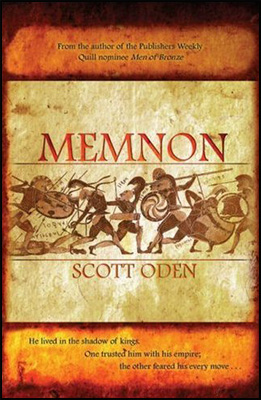
If this post is too long, it’s because I wanted to be sure I didn’t sell its subject short. Scott Oden might take a few liberties with history, but he takes none at all with history’s richness, passion, tragedy, and human irreducibility. As only the best historical novelists can, he offers a past as immediacy-intensified, dramatic, and dangerous as any age’s present. My guess is, Robert E. Howard would be proud to have influenced him.
